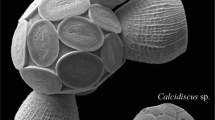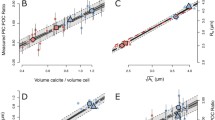Abstract
Processes that impact negatively on CaCO3 production and calcification rates, such as a lowering of the carbonate saturation state of the surface ocean in response to higher atmospheric CO2 levels, can have disastrous consequences for marine ecosystems. This study, however, shows that on a global basis planktonic foraminiferal calcification rates (as inferred from shell-weight) are not related to calcite saturation state, as has been inferred from culture experiments and across a short latitudinal core-top transect. Rather, foraminiferal calcification is apparently a function of the same complex interplay of environmental parameters as assemblage abundance patterns. Highest foraminiferal shell-weights are observed within the optimum ecological niche of each planktonic species and no simple relationship with calcite saturation, temperature or surface nutrient levels exists. The implications of calcification-saturation relationships in calcifying marine ecosystems should therefore be evaluated in a broader context than has been the case in recent studies.


Similar content being viewed by others
References
Anderson DM, Archer D (2002) Glacial-interglacial stability of ocean pH inferred from foraminifer dissolution rates. Nature 416:70–73
Archer D, Maier-Reimer E (1994) Effect of deep-sea sedimentary calcite preservation on atmospheric CO2 concentration. Nature 367:260–263
Barker S, Elderfield H (2002) Foraminiferal calcification response to glacial-interglacial changes in atmospheric CO2. Science 297:833–836
Bé AWH (1977) An ecological, zoogeographic and taxonomic review of recent planktonic foraminifera. In: Ramsay ATS (ed) Oceanic micropaleontology. Adademic Press, London, pp 1–101
Bé AW, Hutson WH (1977) Ecology of planktonic foraminifera and biogeographic patterns of life and fossil assemblages in the Indian Ocean. Micropaleontology 23:369–407.
Bé AW, Tolderlund DS (1971) Distribution and ecology of living planktonic foraminifera in surface waters of the Atlantic and Indian Oceans. In: Funnel BM, Riedel W. (eds) The micropaleontology of oceans. Cambridge University Press, Cambridge, pp 105–149
Broecker WS, Clark E (2001) Glacial-to-Holocene redistribution of carbonate ion in the deep sea. Science 294:2152–2154
Hemleben C, Spindler M, Anderson OR (1989) Modern planktonic foraminifera. Springer, New York Berlin Heidelberg
Keffer T, Martinson DG, Corliss HB (1988) The position of the Gulf Stream during Quaternary glaciations. Science 241:440–442
Kleypas JA, Buddemeier RW, Archer D, Gattuso J-P, Langdon C, Opdyke BN (1999) Geochemical consequences of increased atmospheric carbon dioxide on coral reefs. Science 284:118–120
Lohmann GP (1995) A model for variation in the chemistry of planktonic foraminifera due to secondary calcification and selective dissolution. Paleoceanography 10:445–457
Milliman JD (1993) Production and accumulation of calcium carbonate in the ocean: budget of a nonsteady state. Global Biogeochem Cycles 7:927–957
Riebesell U, Zondervan I, Rost B, Tortell D, Zeebe RE, Morel FMM (2000) Reduced calcification of marine plankton in response to increased atmospheric CO2. Nature 407:364–367
Spero H, Bijma J, Lea DW, Bemis BE (1997) Effect of seawater carbonate ion concentration on foraminiferal carbon and oxygen isotopes. Nature 390:497–500
Villiers S de , Greaves M, Elderfield H (2002) An intensity ratio calibration method for the accurate determination of Mg/Ca and Sr/Ca of marine carbonates by ICP-AES. Geochem Geophys Geosyst 3:2001GC000169
Acknowledgement
Coretop samples were gratefully received from GEOMAR, BOSCOR and A. Mackensen.
Author information
Authors and Affiliations
Corresponding author
Additional information
Communicated by O. Kinne, Oldendorf/Luhe
Rights and permissions
About this article
Cite this article
de Villiers, S. Optimum growth conditions as opposed to calcite saturation as a control on the calcification rate and shell-weight of marine foraminifera. Marine Biology 144, 45–49 (2004). https://doi.org/10.1007/s00227-003-1183-8
Received:
Accepted:
Published:
Issue Date:
DOI: https://doi.org/10.1007/s00227-003-1183-8




